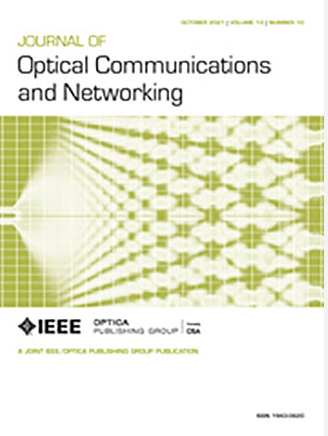面向可扩展无源光动力前传网络
IF 4.3
2区 计算机科学
Q1 COMPUTER SCIENCE, HARDWARE & ARCHITECTURE
引用次数: 0
摘要
无线网络向5G及更远的方向发展,给设计高效、经济的前传网络带来了挑战。本文的重点是功率支持的光前传设计(POFD)问题,该问题寻求优化光分离器的放置及其与无线电单元和分布式单元的连接,同时结合光纤供电(PWoF)技术。PWoF技术通过光纤实现同步数据和电力传输,从而消除了对单独电源单元的需求,提高了网络的弹性,具有显著的优势。然而,POFD问题是np困难的,因为确定最佳分离器放置和互连的复杂性随着网络规模呈指数级增长。为了解决这种复杂性,我们提出了两种全面的基于启发式的方法,并将其性能与基于聚类的方法(如k-means聚类和遗传算法)进行比较。对于可以使用整数线性规划(ILP)计算精确解的小型网络,我们证明了我们的启发式方法可以获得接近最优的结果。对于大型网络,其中ILP在计算上是不可行的,我们的启发式方法提供了可扩展和有效的解决方案,并与文献中不保证可行解决方案的现有基于聚类的方法相比,保持了高性能。本文章由计算机程序翻译,如有差异,请以英文原文为准。
Toward scalable passive optically powered fronthaul networks
The evolution of wireless networks toward 5G and beyond has introduced challenges in designing efficient and cost-effective fronthaul networks. This paper focuses on the power-enabled optical fronthaul design (POFD) problem, which seeks to optimize the placement of optical splitters and their connections to radio units and distributed units while incorporating power over fiber (PWoF) technology. PWoF technology offers significant advantages by enabling simultaneous data and power delivery over optical fibers, thus eliminating the need for separate power units and improving network resilience. However, the POFD problem is NP-hard, as the complexity of determining optimal splitter placements and interconnections grows exponentially with the network size. To address this complexity, we propose two comprehensive heuristic-based approaches and benchmark their performance against clustering-based methods such as k-means clustering and genetic algorithms. For small networks, where exact solutions can be computed using integer linear programming (ILP), we demonstrate that our heuristics achieve near-optimal results. For large networks, where ILP is computationally infeasible, our heuristics provide scalable and effective solutions and maintain high performance compared to existing clustering-based methods in the literature that do not guarantee feasible solutions.
求助全文
通过发布文献求助,成功后即可免费获取论文全文。
去求助
来源期刊
CiteScore
9.40
自引率
16.00%
发文量
104
审稿时长
4 months
期刊介绍:
The scope of the Journal includes advances in the state-of-the-art of optical networking science, technology, and engineering. Both theoretical contributions (including new techniques, concepts, analyses, and economic studies) and practical contributions (including optical networking experiments, prototypes, and new applications) are encouraged. Subareas of interest include the architecture and design of optical networks, optical network survivability and security, software-defined optical networking, elastic optical networks, data and control plane advances, network management related innovation, and optical access networks. Enabling technologies and their applications are suitable topics only if the results are shown to directly impact optical networking beyond simple point-to-point networks.

 求助内容:
求助内容: 应助结果提醒方式:
应助结果提醒方式:


